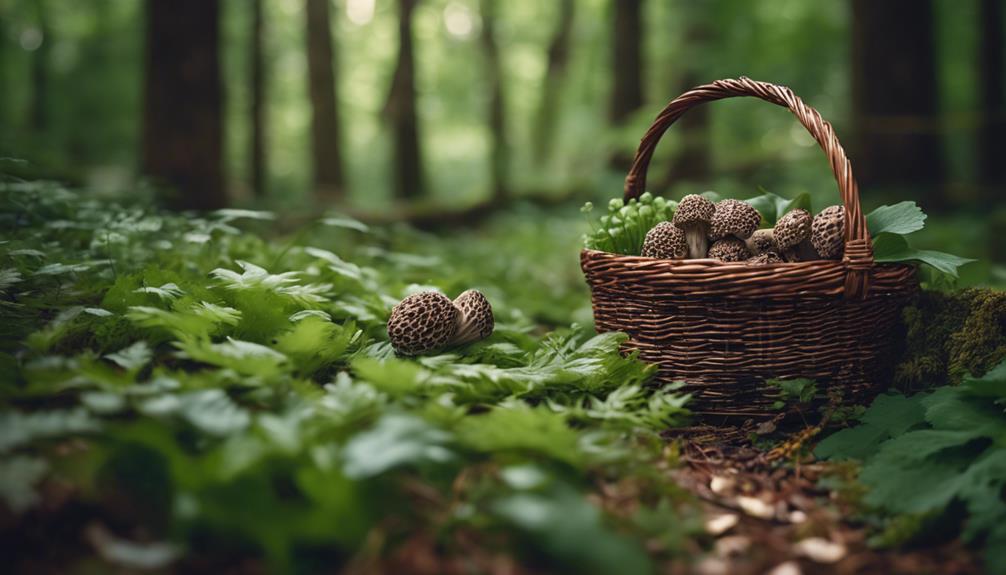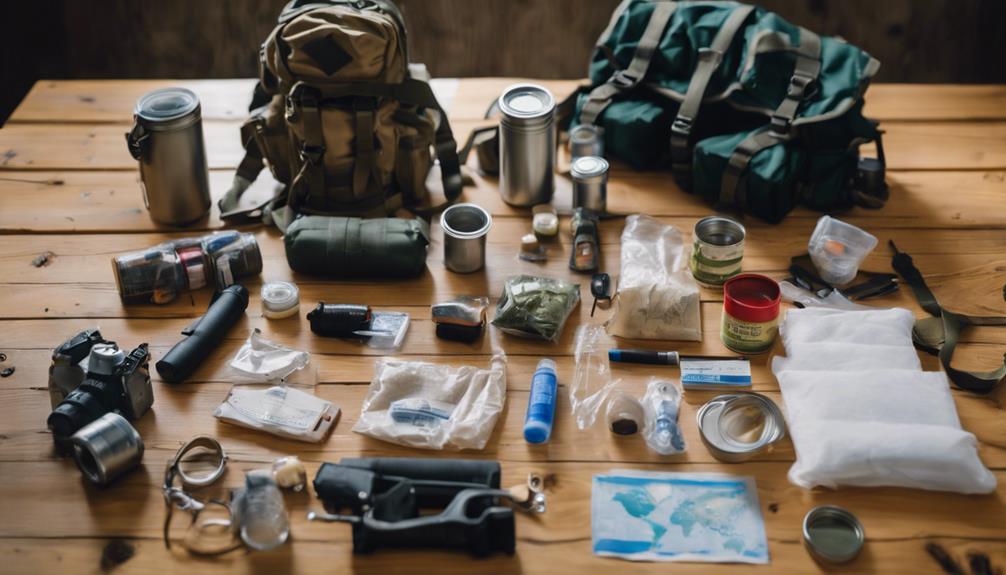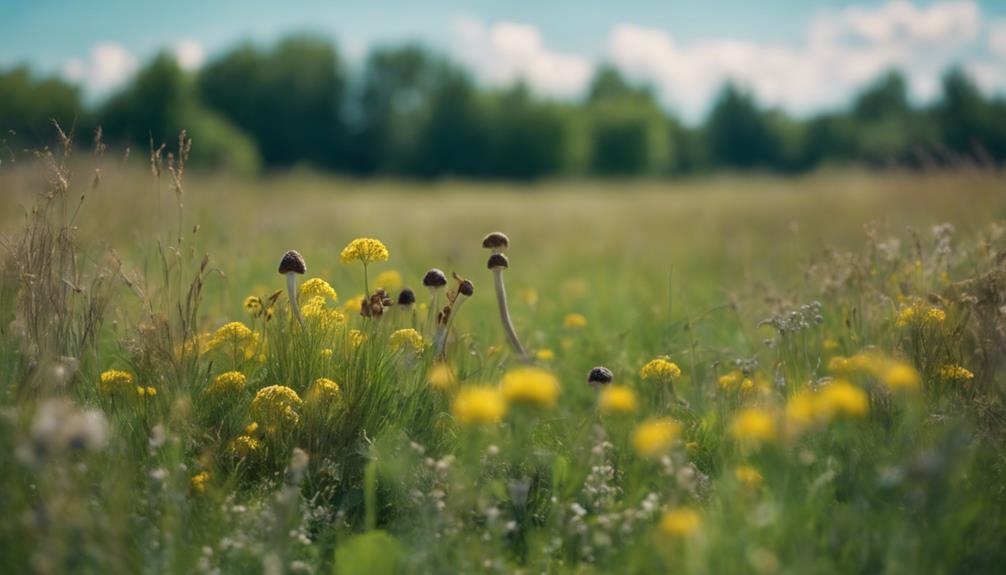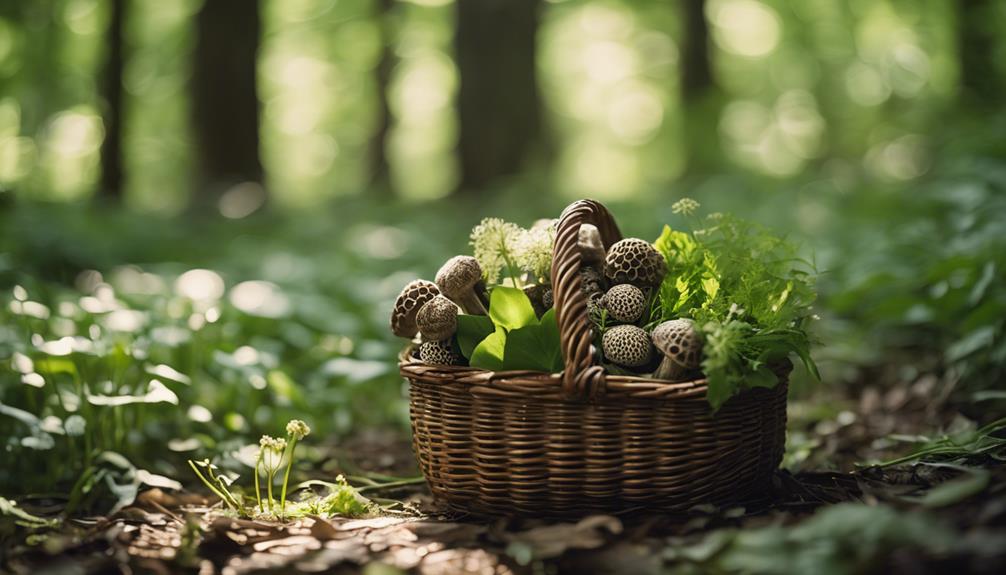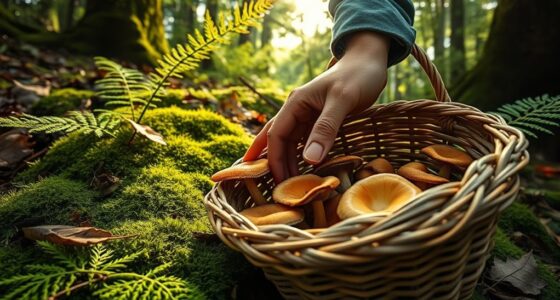You're prepared to access Michigan's wild bounty! From mastering fundamental foraging skills to recognizing edible plants and avoiding toxic lookalikes, you'll discover the secrets to sustainable harvesting. Explore Michigan's diverse ecosystems, where you'll find hidden gems like morels, ramps, and thimbleberries. Learn how to identify, harvest, and cook with wild edibles, accessing their nutritional benefits. Plus, get tips on sustainable foraging techniques, cooking methods, and more. As you venture into the world of foraging, you'll uncover the rich flavors and nutritional treasures of Michigan's wild bounty – and there's so much more to discover. As you expand your skills, you might even consider venturing beyond Michigan to explore neighboring states like Wisconsin, where foraging opportunities abound. Learning **how to forage in Wisconsin** opens up a whole new world of wild edibles, including unique species that thrive in its varied landscapes. Whether you’re foraging in Michigan or learning **how to forage in Wisconsin**, the journey will continually deepen your connection to nature and its seasonal abundance.
Key Takeaways
- Master fundamental skills like recognizing edible plants, distinguishing lookalikes, and understanding seasonal cycles and habitats to forage like a pro in Michigan.
- Identify Michigan's unique wild edibles like morels, ramps, and thimbleberries, and learn specific habitats and seasons for foraging.
- Develop confidence in plant identification and safety by understanding leaf shape, flower color, and root system, and learning about toxic look-alikes.
- Adapt harvesting practices to Michigan's changing seasons, focusing on abundance and variety to reap nutritional benefits from vitamin-rich wild edibles like dandelions and berries.
- Practice sustainable foraging techniques, such as selective harvesting and avoiding over-harvesting, to promote environmental conservation and ecosystem health.
Foraging Fundamentals 101
To kick-start your foraging journey in Michigan, mastering the fundamental skills of identifying and harvesting wild edibles is essential for ensuring a safe and sustainable foraging experience. You'll want to focus on recognizing edible plants, which is a pivotal aspect of Foraging Fundamentals 101.
Learning to identify these plants will help you avoid mistakenly picking something inedible or even toxic. You'll discover the skills to distinguish between lookalikes, understand the importance of proper plant identification, and develop the confidence to forage with ease.
In Foraging Fundamentals 101, you'll also learn about seasonal cycles and habitats, essential knowledge for finding the right spots to forage. You'll understand how to harvest edible plants sustainably, ensuring that the ecosystem remains balanced.
By grasping these fundamental skills, you'll be well on your way to becoming a proficient forager, capable of finding and preparing delicious wild edibles in Michigan. Remember, proper identification and ethical harvesting practices are key to a successful and sustainable foraging experience.
With Foraging Fundamentals 101, you'll gain the knowledge and skills necessary to enjoy the bounty of Michigan's wild edibles.
Michigan's Edible Plant Landscape

As you explore Michigan's edible plant landscape, you'll discover a world of flavors and textures waiting to be uncovered.
From the forest floor to the woodland canopy, the state's diverse landscape is home to a wide range of delicious and nutritious edibles.
Get ready to uncover the secrets of Michigan's woodland delicacies, learn how to forage by season, and uncover the hidden gems of the forest floor.
Woodland Delicacies Abound
Michigan's woodlands burst with an incredible array of edible treasures, from the prized morel mushrooms and pungent ramps to the sweet and succulent pawpaws, waiting to be discovered by intrepid foragers. As you venture into the forest, you'll find a wealth of wild berries, including serviceberries, thimbleberries, and wild blueberries. These delicious treats are ripe for the picking, but a thorough understanding of the plant habitats and growth cycles is crucial for a successful harvest.
| Plant | Habitat | Harvest Season |
|---|---|---|
| Morels | Rich soil, deciduous forests | Spring |
| Ramps | Moist, woodland areas | Early spring |
| Pawpaws | Rich soil, woodland edges | Late summer |
| Serviceberries | Open woodlands, meadows | Summer |
| Thimbleberries | Woodland edges, streams | Summer |
Forest Floor Foraging
Beyond the trees' towering canopies, your foraging adventure begins on the forest floor, where a tapestry of edible plants awaits discovery.
As you venture into Michigan's forest, you'll uncover a diverse array of edible wild plants, including Wild Leeks (Ramps) and Thimbleberry. To successfully forage on the forest floor, it's important to understand the habitats and growth cycles of these plants.
You'll need to develop a keen eye for identification, as some toxic look-alikes can masquerade as edible wild plants. Wild Leeks, a popular choice among foragers, add a delicious onion-garlic flavor to dishes.
When you do find edible plants, proper processing and storage techniques are essential to keep them fresh and safe for consumption. By mastering these skills, you'll reveal the secrets of Michigan's forest floor, where a world of edible wild delights awaits.
As you explore this uncharted territory, remember to respect the land, harvest sustainably, and always prioritize your safety.
Wild Edibles by Season
You'll find that Michigan's wild edibles are scattered throughout the year, with each season bringing its unique offerings to the foraging table. As you explore the state's edible landscape, you'll discover that each time of year presents new opportunities to forage for delicious and nutritious wild edibles.
In the spring, you can search for wild leeks, ramps, and morel mushrooms, which add a pungent flavor to any dish.
Summer brings an abundance of juicy berries like raspberries, blueberries, and blackberries, perfect for snacking or baking.
As fall arrives, you can forage for nuts like walnuts and hickory nuts, as well as persimmons and pawpaws, which make great additions to savory dishes.
Even in the winter, Michigan's wild edibles persist. You can forage for evergreen needles or wintergreen berries, which offer unique flavors to add to your recipes.
Plant Identification and Safety

When venturing into the world of foraging, proper plant identification is key to avoiding the dangers of mistakenly consuming toxic look-alikes. You must understand that accurately identifying edible plants is essential for a safe and successful foraging experience. To do this, you'll need to familiarize yourself with plant parts like leaf shape, flower color, and root system.
Here's a breakdown of what to look for in three common wild edibles:
| Plant | Leaf Shape | Flower Color |
|---|---|---|
| Wild Strawberry | Triangular | White |
| Wild Blueberry | Oval | Pink |
| Burdock | Heart-shaped | Purple |
Harvesting Wild Foods Seasonally

How do you maintain a steady supply of fresh, nutritious wild foods throughout the year, despite Michigan's changing seasons?
The answer lies in understanding the seasonal cycles of wild plants and adjusting your harvesting practices accordingly. In Michigan, different wild foods are available for foraging based on the season. For example, morel mushrooms are abundant in the spring, while berries ripen in the summer.
By foraging seasonally, you can enjoy a wide range of flavors and nutritional benefits throughout the year. Seasonal variations impact the availability and quality of wild foods, so it's essential to adapt your foraging strategies to match the changing landscape.
Nutritional Benefits of Foraging

As you explore the world of foraging, you'll discover that wild edibles are packed with vitamins, minerals, and antioxidants that can elevate your health to the next level.
By incorporating these nutrient-dense foods into your diet, you'll be able to access their incredible nutritional benefits.
From vitamin-rich wild edibles to mineral-dense foraged foods and antioxidant powerhouses, you're about to reveal the secrets to a healthier, more balanced you.
Vitamin-Rich Wild Edibles
You can supercharge your diet with a wealth of vitamin-rich wild edibles, from dandelions and nettles to berries, that are packed with essential nutrients. These wild foods offer a diverse range of vitamins, including C, A, and K, as well as minerals like iron and calcium. By incorporating these wild edibles into your diet, you can boost your intake of antioxidants, fiber, and phytonutrients.
| Wild Edible | Nutritional Benefits |
|---|---|
| Dandelion | Rich in vitamins A, C, and K, and minerals like potassium and iron |
| Nettles | High in vitamins A, C, and K, and minerals like calcium and iron |
| Wild Garlic | Rich in vitamins C and B6, and minerals like potassium and manganese |
Incorporating these vitamin-rich wild edibles into your diet can have a significant impact on your overall well-being and nutritional intake. Wild garlic, chickweed, and other foraged foods are known for their immune-boosting properties and health benefits. By foraging for these wild foods, you can enhance your health and nutrition, and experience the benefits of a more balanced diet.
Mineral-Dense Foraged Foods
When foraging for wild edibles, you'll uncover a treasure trove of mineral-dense foods that can greatly enhance your intake of essential nutrients like iron, calcium, and magnesium. These nutrients are often lacking in our modern diets, but foraged foods can help bridge the gap.
Wild berries, for instance, are a great source of manganese, a mineral essential for bone health and metabolism. Mushrooms, another common foraged food, are rich in copper, which supports immune function and connective tissue health.
By incorporating these mineral-dense foods into your diet, you can promote excellent health and well-being. Foraging provides an opportunity to diversify your diet with nutrient-rich wild plants that can supplement a balanced diet with essential minerals not commonly found in processed foods.
Antioxidant Powerhouses Found
Foraging for wild edibles like berries and mushrooms releases a powerful arsenal of antioxidants that can help combat oxidative stress and inflammation in your body.
As you venture into the world of foraging, you'll discover that wild plants are packed with antioxidants that can boost your overall health. These antioxidant powerhouses can help fight off chronic diseases and even support heart health.
By consuming wild foods, you'll introduce a variety of antioxidants into your diet that can help reduce oxidative stress and inflammation. This, in turn, can lead to a stronger immune system and improved overall health.
Compared to cultivated foods, wild edibles offer higher levels of vitamins, minerals, and phytonutrients, making them a nutritional powerhouse.
Sustainable Foraging Techniques

By embracing sustainable foraging techniques, individuals can guarantee that their wild food harvests don't harm the environment, and instead, contribute to the preservation of natural resources for future generations.
When you're out foraging for edible greens like dandelion or chicory, it's crucial to prioritize sustainable methods. This means being selective in your harvesting, avoiding over-harvesting, and respecting plant populations. By doing so, you'll make sure that the ecosystems and wildlife habitats remain healthy and thriving.
Sustainable foraging techniques not only promote environmental conservation but also contribute to biodiversity, ecosystem health, and the longevity of natural resources.
As you explore Michigan's wild bounty, remember that responsible harvesting practices are key to enjoying the benefits of wild foods while preserving the environment. By adopting sustainable foraging techniques, you'll be contributing to a healthier planet for generations to come.
Cooking With Wild Edibles

As you've mastered the art of sustainable foraging, now it's time to get creative in the kitchen, where the real magic happens, and your wild edibles take center stage. Cooking with wild edibles is an exciting way to add unique flavors and nutritional benefits to your recipes. You can incorporate foraged ingredients like dandelions, nettles, and chickweed into salads, soups, and teas.
Here are some ideas to get you started:
| Wild Edible | Cooking Ideas |
|---|---|
| Ramps (Wild Leeks) | Sautéed, Pickled, or in Pesto |
| Serviceberries | Salads, Smoothies, or as a Topping |
| Dandelion Greens | Salads, Soups, or Sauteed with Garlic |
| Edible Berries | Salads, Smoothies, or as a Topping |
Remember to properly identify and prepare your wild edibles to avoid harmful toxins or allergic reactions. With a little creativity, you can create delicious and nutritious dishes that showcase Michigan's wild bounty. So, get cooking and enjoy the flavors of the great outdoors!
Exploring Michigan's Ecosystems

Michigan's diverse ecosystems, which you'll soon discover, offer a wide range of wild edibles waiting to be uncovered. As you explore the state, you'll encounter wetlands, forests, and open areas, each with its unique characteristics and edible treasures.
Wetlands and aquatic flora, for instance, are home to Broadleaf Arrowhead and Cattail, two popular choices for foraging. Forest floors and understories hide gems like Wild Leek and Thimbleberry, while fields and open areas boast Prairie Turnip and Common Milkweed.
Each ecosystem provides a distinct habitat shaped by factors like moisture levels and sunlight availability. Understanding these ecosystems is key to finding the best wild edibles. By recognizing the unique conditions of each environment, you'll increase your chances of stumbling upon hidden gems.
As you venture into Michigan's ecosystems, keep an eye out for the subtle differences that make each one special. With patience and practice, you'll become adept at identifying the perfect spots to forage for wild edibles. So, get ready to explore and uncover the secrets of Michigan's diverse ecosystems!
Resources for Michigan Foragers

You'll find a wealth of resources available to help you master the art of foraging in Michigan, from university workshops to detailed field guides. Michigan State University offers workshops on field identification and culinary applications, providing hands-on experience and expert knowledge. For a more self-guided approach, field guides provide detailed descriptions and habitat information for Michigan's native edible plants. These resources are essential for proper identification, ensuring safe and sustainable foraging practices.
| Resource | Description |
|---|---|
| Michigan State University Workshops | Hands-on field identification and culinary applications |
| Field Guides | Detailed descriptions and habitat information for Michigan's native edible plants |
| Online Forums | Connect with experienced foragers, share tips, and learn from others |
| Guided Foraging Tours | Explore Michigan's diverse ecosystems with expert guides |
Frequently Asked Questions
What Is the Rule of Thumb for Foraging?
When you're foraging, remember that the rule of thumb is to always positively identify wild edibles before consumption to avoid toxic species, so you don't end up eating something harmful.
How to Forage Properly?
'When you're foraging, think of yourself as a detective, searching for clues to identify the perfect edible. You seek guidance from experts, avoid contaminated areas, cook mushrooms, and test new species in small amounts to guarantee a safe and delicious harvest.'
How Do Beginners Do Forage?
You start foraging by learning to identify common edibles, investing in essential tools, and practicing ethical foraging; then, you'll be ready to explore the wild world of foraging, taking only what you need while respecting the environment.
How to Become a Good Forager?
As you wander through the woods, imagine being a detective, searching for clues to uncover nature's hidden treasures. To become a good forager, you'll need to develop your observation skills, patience, and knowledge of the natural world.
Conclusion
As you venture into Michigan's wild, remember that foraging isn't just about finding food – it's about forging a connection with the land.
Imagine the state's edible landscape as a tapestry, woven with threads of wild berries, medicinal herbs, and ancient forests.
By embracing sustainable foraging practices, you'll become the thread that strengthens this delicate fabric, preserving Michigan's natural beauty for generations to come.

